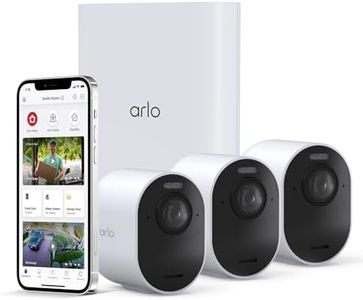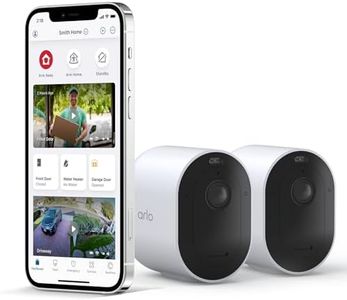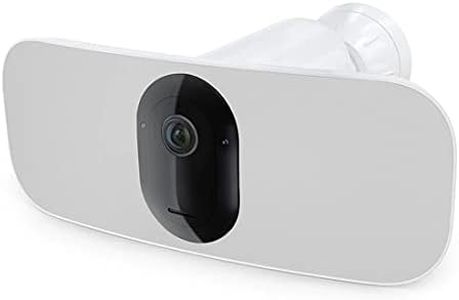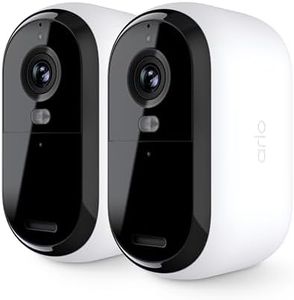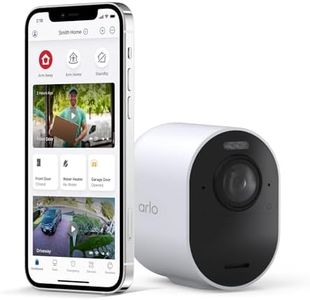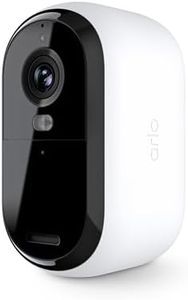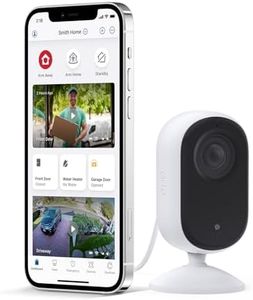We Use CookiesWe use cookies to enhance the security, performance,
functionality and for analytical and promotional activities. By continuing to browse this site you
are agreeing to our privacy policy
8 Best Arlo Cameras
From leading brands and best sellers available on the web.Buying Guide for the Best Arlo Cameras
When choosing an Arlo camera, it's important to think about where and how you plan to use it—for example, whether it will be used indoors or outdoors, whether you'd like to monitor a front door or a back yard, and if you prefer wired or wireless operation. By understanding your needs and the environment where the camera will be installed, you can better match the key features with your intended purpose. This will result in a more satisfying experience and a camera setup that works well for your specific situation.ResolutionResolution refers to the clarity of the video footage captured by the camera, typically measured in megapixels or as a standard like 1080p, 2K, or 4K. Higher resolutions capture more detail, which makes it easier to recognize faces, license plates, or other important features. If you need clear, detailed images—such as for monitoring large areas or identifying people—a higher resolution is helpful. For basic monitoring, like knowing if someone enters your yard, standard HD (1080p) is usually enough. Choose higher resolution if you want details for identification and a lower one if you’re mainly looking for activity alerts.
Field of ViewField of view is the width of the area the camera can see, measured in degrees. A wider field of view lets you monitor a larger area with a single camera, which is useful for yards or open spaces. Narrower fields of view can focus on driveways or entryways more closely. If you only need to watch a door, a smaller field of view is fine, but if you're watching a wide area, look for a larger number.
Power SourceArlo cameras can be powered by batteries, plugged into an outlet, or connected through solar panels. Battery-powered cameras are flexible and easy to install anywhere, but will need to be recharged occasionally. Wired cameras don’t need recharging, but require access to a power source. Choose battery-powered for flexibility or places without easy access to outlets, and wired for locations where constant power and less maintenance are more important.
Night VisionNight vision allows the camera to record clear video in the dark. Basic night vision uses infrared light to create black-and-white images, while more advanced versions may offer color night vision. If you need to capture details at night around your home or property, consider more advanced night vision. For areas with some lighting or if night recordings aren’t critical, standard infrared is usually sufficient.
Two-Way AudioTwo-way audio lets you hear sound from the camera’s location and speak through the camera using your phone or computer. This feature is handy if you want to talk to visitors or warn off intruders. If you want more than just passive monitoring, such as greeting delivery people or interacting with family, two-way audio adds value. If you don’t plan to communicate through the camera, this may not be important.
Storage OptionsArlo cameras can store video on the cloud or on local devices. Cloud storage lets you access footage from anywhere, but usually requires a subscription. Local storage, such as a microSD card or USB drive, keeps footage onsite and may save ongoing costs. If you want to access your video anywhere and don’t mind subscriptions, cloud storage is convenient. If you want to avoid ongoing fees and keep everything local, ensure the model supports local storage.
Smart FeaturesSome Arlo cameras offer features like motion detection, person, animal, or package recognition, and automated alerts. These features help reduce unwanted notifications and make it easier to manage monitoring. If you want precise notifications and less hassle, advanced smart features are helpful. For simpler setups, basic motion detection may be enough.
Weather ResistanceThis refers to how well the camera can handle outdoor conditions like rain, dust, or extreme temperatures. Cameras with higher weather resistance are better suited for outdoor use and will last longer in exposed environments. If you’re installing the camera outside, look for models with strong weatherproof ratings. For indoor use, this spec is less important.

